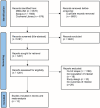Prevalence and epidemiology of stroke in patients with multiple sclerosis: a systematic review and meta-analysis
- PMID: 38573365
- PMCID: PMC11233381
- DOI: 10.1007/s00415-024-12331-2
Prevalence and epidemiology of stroke in patients with multiple sclerosis: a systematic review and meta-analysis
Abstract
Background: Epidemiological data are sparse regarding the risk of stroke in patients with multiple sclerosis (MS).
Objective: To estimate the following: (1) the pooled prevalence of all-cause stroke, acute ischaemic stroke (AIS) and intracerebral haemorrhage (ICH) in MS patients; (2) the relative risk for all-cause stroke, AIS and ICH in MS patients compared to the general population; (3) associations between patient characteristics and the risk for AIS and ICH in MS patients.
Methods: Systematic review and meta-analysis of registry-based and cohort studies.
Results: Thirteen observational studies comprising 146,381 MS patients were included. The pooled prevalence of all-cause stroke was 2.7% (95% confidence interval [CI] 1.3-4.6%), with the relative risk of all-cause stroke being higher in MS patients compared to the general population (RR: 2.55; 95% CI 1.97-3.29). Subgroup analyses per stroke subtype revealed a pooled AIS prevalence of 2.1% (95% CI 0.8-4.1%) and a pooled ICH prevalence of 0.6% (95% CI 0.2-1.2%). Compared to the general population, patients with MS were found to harbour an increased risk for AIS (RR: 2.79; 95% CI 2.27-3.41) and ICH (RR: 2.31; 95% CI 1.04-5.11), respectively. The pooled prevalence of cardiovascular risk factors in MS patients was 11.5% (95% CI 2.9-24.7%) for dyslipidaemia, 18.2% (95% CI 5.9-35.3%) for hypertension and 5.4% (95% CI 2.1-10.2%) for diabetes. In meta-regression, age was negatively associated with AIS risk (β = - .03, p = 0.04), with a 1-year increase in age resulting in a significant 3% (95%CI 0-5) attenuation of the risk of AIS.
Conclusion: The findings of the present meta-analysis indicate that MS is associated with an increased risk for ischaemic and haemorrhagic stroke. Future well-designed epidemiological studies are warranted to corroborate the robustness of the present findings in the MS population.
Keywords: Cardiovascular risk factors; Cerebrovascular disease; Intracerebral haemorrhage; Multiple sclerosis; Stroke.
© 2024. The Author(s).
Conflict of interest statement
Dr. Stefanou—nothing to report. Dr. Giannopapas—nothing to report. Dr. Kitsos—nothing to report. Dr. Chondrogianni—nothing to report. Dr. Theodorou—nothing to report. Dr. Kosmidou—nothing to report. Dr. Vlotinou—nothing to report. Dr. Bakirtzis—nothing to report. Dr. Andreadou—nothing to report. Dr. Tzartos—nothing to report. Dr. Giannopoulos—nothing to report. Dr. Tsivgoulis—nothing to report.
Figures







References
-
- Strober LB, Christodoulou C, Benedict RH, Westervelt HJ, Melville P, Scherl WF, Weinstock-Guttman B, Rizvi S, Goodman AD, Krupp LB. Unemployment in multiple sclerosis: the contribution of personality and disease. Mult Scler. 2012;18:647–653. - PubMed
-
- Koch-Henriksen N, Sørensen PS. The changing demographic pattern of multiple sclerosis epidemiology. Lancet Neurol. 2010;9:520–532. - PubMed
-
- Leray E, Moreau T, Fromont A, Edan G. Epidemiology of multiple sclerosis. Rev Neurol (Paris) 2016;172:3–13. - PubMed
-
- Spencer JI, Bell JS, DeLuca GC. Vascular pathology in multiple sclerosis: reframing pathogenesis around the blood-brain barrier. J Neurol Neurosurg Psychiatry. 2018;89:42–52. - PubMed
Publication types
MeSH terms
LinkOut - more resources
Full Text Sources
Medical

